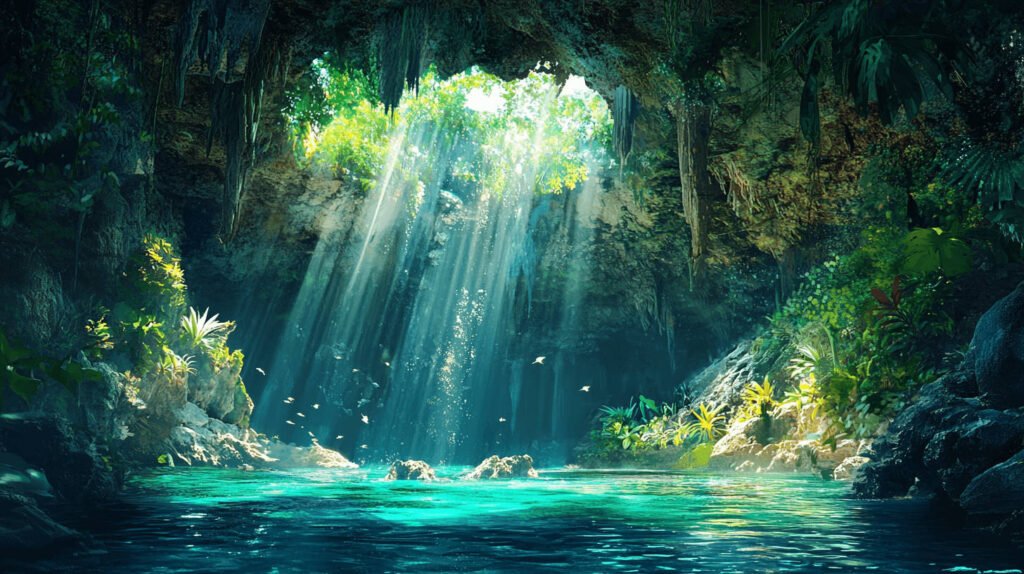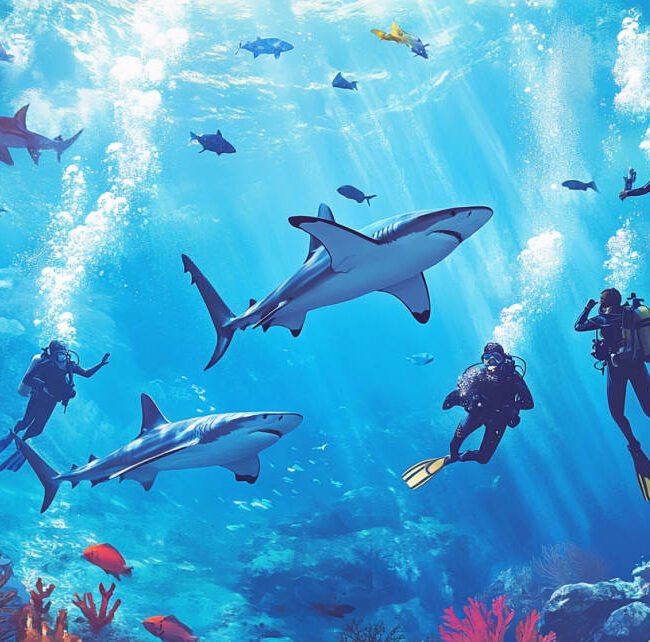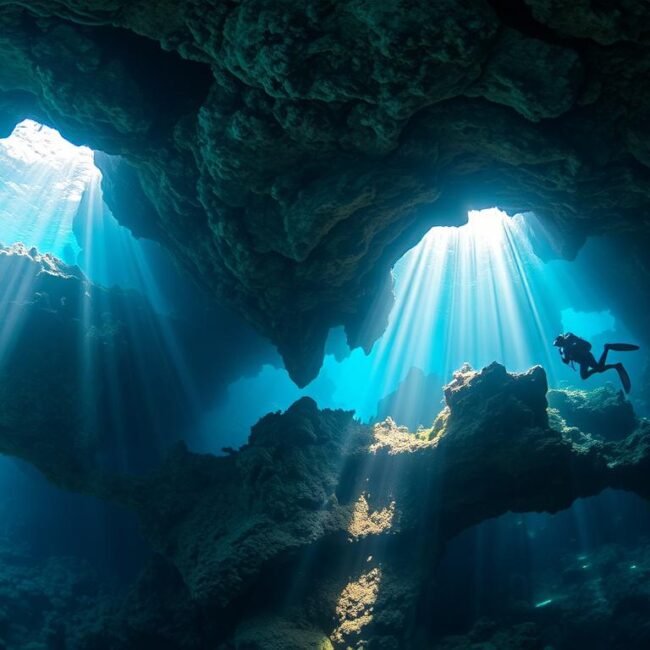Did you know that Mexico boasts over 6,000 cenotes, making it a dream destination for scuba enthusiasts? If you’ve ever imagined gliding through crystal-clear waters and exploring magical underwater caves but thought it was only for seasoned divers, think again! As a beginner, you have the incredible opportunity to dive into some of the most breathtaking and accessible caves in the world. Let’s dive right in and uncover the top spots you simply can’t miss!
Why Mexico is a Top Destination for Beginner Cave Divers
So, you’re thinking about diving into the mysterious underwater caves of Mexico? Let me tell you, you’re making a fantastic choice! Mexico is like a playground for newbie cave divers, and I couldn’t believe how perfect it was when I first dipped my fins into those crystal-clear waters.
Abundance of Beginner-Friendly Dive Sites
First off, Mexico is loaded with caves that are just right for beginners. Seriously, it’s like the country was designed with newbie divers in mind! When I was starting out, I was a bit nervous about venturing into caves. But the sheer number of beginner-friendly sites put my mind at ease. From shallow caverns to easy-access cenotes, you’ve got options galore. I remember thinking, “Man, I could spend months here and not hit all these spots!”
Warm Waters and Excellent Visibility
Now, let’s talk about the water—it’s warm and inviting, kinda like a tropical bath. None of that teeth-chattering cold you might experience elsewhere. The temperatures hover around a comfy 77°F (25°C), so you can focus on exploring rather than shivering! And the visibility? Oh boy, it’s something else. On my dives, I could see for what felt like forever. The clear views make it so much easier to navigate and truly appreciate the underwater beauty.
Rich Underwater Ecosystems
One of the coolest things I discovered was the incredible marine life. The ecosystems are so rich and diverse, it’s like diving into an episode of a nature documentary! I still get goosebumps thinking about the time a curious turtle swam right up to me. You’ll encounter all sorts of unique creatures that make each dive an unforgettable experience.
Expert Dive Instructors and Facilities
Lastly, the dive instructors and facilities in Mexico are top-notch. These folks know their stuff and are super passionate about sharing it with you. My instructor was this chill guy named Carlos who had the patience of a saint. I was all thumbs with my gear at first, but he guided me through every step. Plus, the dive shops are well-equipped, offering everything from gear rentals to safety briefings. They’ve got your back, making sure you’re safe and ready to roll.
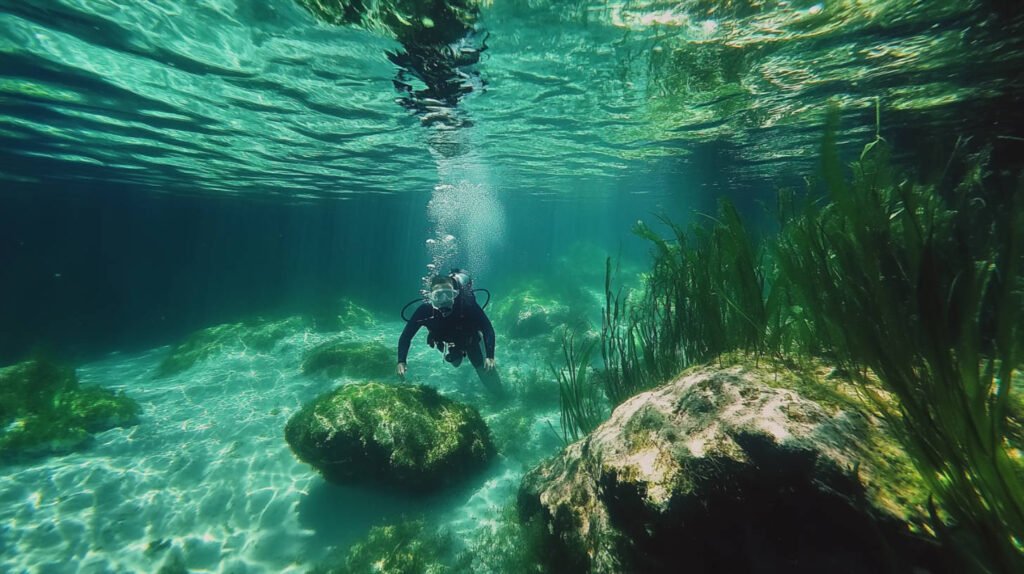
Understanding Cenotes: Mexico’s Unique Underwater Caves
Alright, let’s dive (pun totally intended) into what makes Mexico’s caves so unique—the cenotes! If you’ve never heard of them, get ready to have your mind blown.
What Are Cenotes?
Cenotes are natural sinkholes formed when limestone bedrock collapses, revealing the groundwater underneath. Imagine swimming in a natural pool surrounded by ancient rock formations—it’s surreal! The water is so clear, it feels like you’re floating in air. The first time I jumped into a cenote, I was like, “Is this real life?” It’s an experience unlike any other.
Historical and Cultural Significance
But wait, there’s more! Cenotes aren’t just geological wonders; they’re steeped in history and culture. The ancient Maya considered them sacred portals to the underworld. They performed rituals and made offerings in these very spots. Knowing that you’re exploring a place with such deep historical roots adds a whole new layer to the adventure. I felt like I was part of something much bigger than just a dive.
Ideal for Beginners
Now, you might be thinking, “This sounds amazing, but is it cool for beginners?” Absolutely! Cenotes are perfect for novice divers. The waters are calm, and the depths are manageable. I was a bit jittery before my first cenote dive, but once I was in, all that anxiety washed away—literally! The environment is so forgiving that you can focus on enjoying the scenery rather than worrying about currents or tricky conditions.
Stunning Natural Beauty
The beauty of cenotes is off the charts. Sunlight filters through openings in the cave ceiling, creating mesmerizing beams of light underwater. It’s like something out of a fantasy novel! And the geological formations? Mind-blowing. Stalactites and stalagmites create intricate patterns that make each dive feel like a journey through an alien landscape. I often found myself just floating there, soaking it all in, and thinking, “I can’t believe this place exists!”
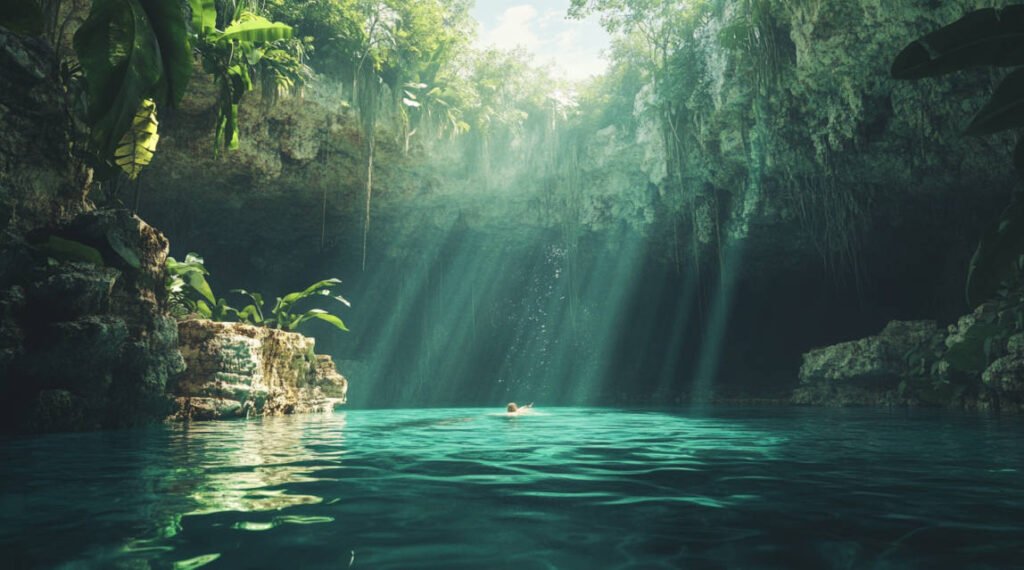
Essential Tips for Beginner Cave Divers
Alright, so you’re pumped and ready to go. But before you plunge in, let me share some tips that I wish someone had told me when I was starting out.
Obtain Necessary Certifications
First things first—you gotta get certified. I know, I know, paperwork and classes might sound boring, but trust me, it’s crucial. You’ll need at least an Open Water Diver certification, and for cave diving, a Cavern Diver certification is often recommended. I remember feeling a bit overwhelmed during my course, but once I had that certification in hand, I felt like I could conquer the underwater world!
Dive with a Guide
This isn’t the time to go solo, my friend. Always dive with an experienced guide or instructor, especially in caves. On my first cave dive, my guide was invaluable. He knew all the nooks and crannies, pointing out hidden features and keeping us on the safe path. Plus, having someone who knows the area like the back of their hand adds a huge layer of comfort.
Proper Gear and Equipment
Don’t skimp on your gear—seriously. Invest in good-quality equipment or rent from reputable dive shops. You’ll need a reliable wetsuit, fins, mask, and definitely a good dive light. I made the rookie mistake of buying a cheap dive light online, and it flickered out halfway through a dive. Not cool! Also, make sure everything fits properly. Ill-fitting gear can turn an awesome dive into an uncomfortable slog.
Master Buoyancy Control
Buoyancy control is like the secret sauce of enjoyable diving. Being able to hover effortlessly without bobbing up and down makes a world of difference. I spent extra time in the pool practicing this, and it paid off big time. Not only does it make your dive smoother, but it also helps protect the delicate cave formations from accidental bumps. Plus, it’s kinda fun to feel like you’re defying gravity!
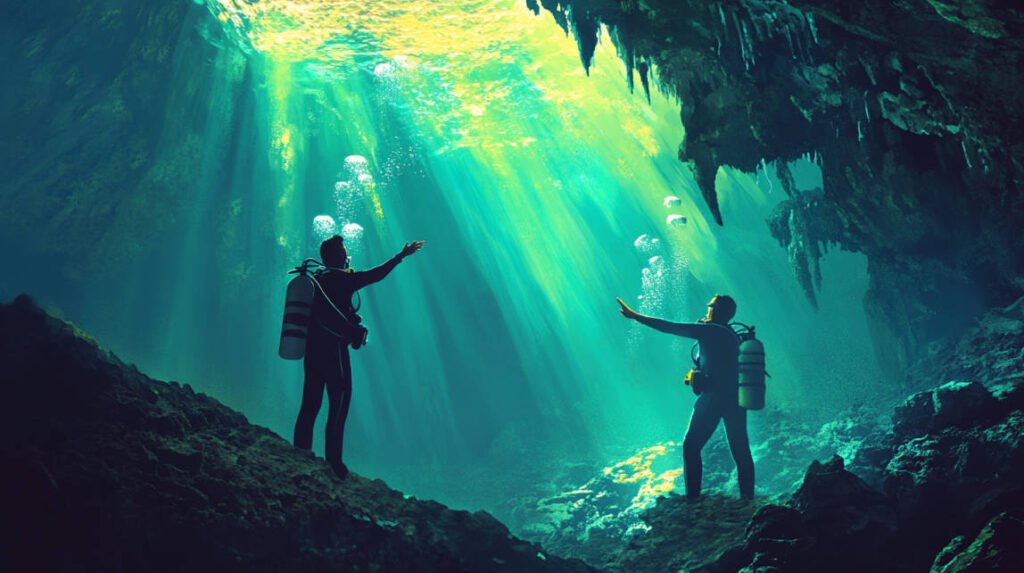
Top 10 Best Caves for Scuba Diving in Mexico for Beginners
Alright, let’s get to the main event—the top 10 caves that are absolute must-dives for beginners in Mexico! Trust me, you won’t want to miss these spots. Each one offers something unique, and I’ve got some personal tidbits to share about them.
1. Dos Ojos Cenote
Located near Tulum, easily accessible.
Let me tell you about Dos Ojos, which means “Two Eyes” in Spanish. This cenote got its name from the two neighboring sinkholes that are connected by a large cavern. When I first arrived, I was blown away by how easy it was to get there. A short drive from Tulum, and boom—you’re in paradise!
Features two connected caverns with impressive stalactites.
Diving here felt like exploring an underwater cathedral. The stalactites hanging from the ceiling are nothing short of majestic. I remember accidentally bumping my head on one because I was too busy gawking at the scenery—rookie mistake!
Shallow depths ideal for beginners.
The depths here are shallow, ranging from 16 to 70 feet, making it perfect for those of us still getting comfortable underwater. I felt completely at ease, knowing I wasn’t venturing too deep.
Known for its clear blue waters and extensive light zones.
The visibility is insane—like swimming in liquid glass. Sunlight filters through openings, creating ethereal light zones. I spent a good chunk of my dive just floating and soaking it all in. Honestly, it’s one of those places where you wish time would just stand still.
2. Gran Cenote
Close to Tulum, popular among new divers.
Gran Cenote is another gem that’s super close to Tulum. It’s a hot spot for beginners, so you’ll likely meet fellow newbie divers swapping stories and tips.
Home to turtles and small fish.
One of the highlights here is the wildlife. I was lucky enough to swim alongside a friendly turtle who didn’t seem to mind my presence at all. There are also schools of tiny fish that flit around, adding to the magic.
Offers facilities like restrooms and gear rentals.
Convenience is key, right? Gran Cenote has all the amenities you need—clean restrooms, gear rentals, even a little snack bar. It’s a hassle-free experience from start to finish.
Open areas with ample natural light.
The cenote has both open and cavern areas, so you can choose your own adventure. The natural light makes it less intimidating for beginners. I felt super comfortable exploring the open sections before venturing into the caverns.
3. Cenote Chac Mool
Situated near Playa del Carmen.
If you’re hanging around Playa del Carmen, Chac Mool is a must-visit. It’s just a short trip away, making it a convenient option for a day dive.
Mix of open water and overhead environments.
What I love about Chac Mool is the variety. You get a mix of open water and overhead environments, so it’s like getting two dives in one. It’s a great place to test your skills and gain confidence.
Features haloclines where fresh and saltwater meet.
Okay, this is where things get trippy—in a good way! The halocline effect here is wild. When the fresh and saltwater layers meet, it creates a blurred vision that feels like you’re in a dream. The first time it happened, I thought my mask was fogging up!
Beautiful light beams penetrate the water.
The light show at Chac Mool is next level. Beams of sunlight pierce through the water, illuminating the cavern in the most spectacular way. It’s like Mother Nature’s own laser show.
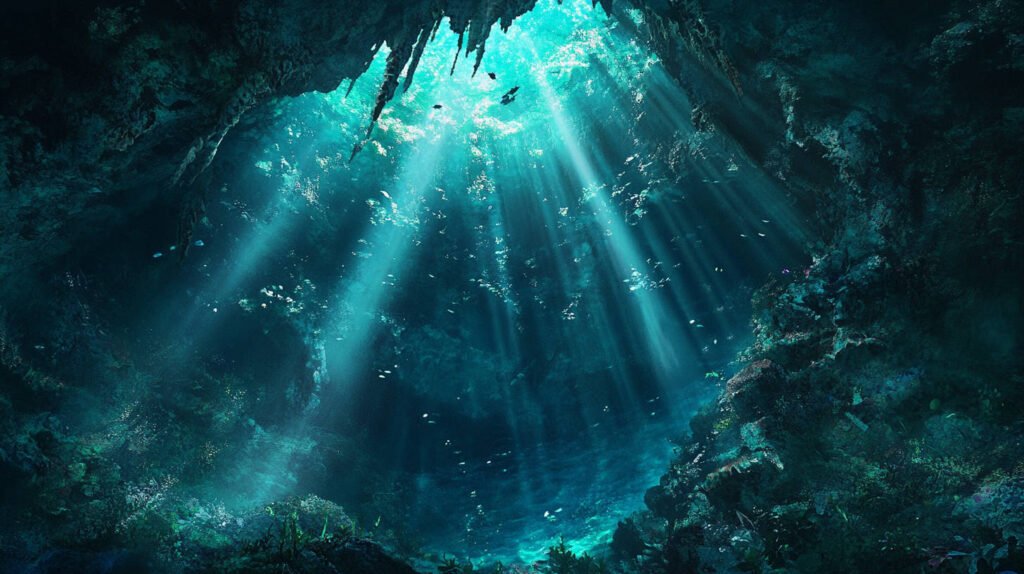
4. Cenote Tajma Ha
Located on the Riviera Maya.
Nestled along the Riviera Maya, Cenote Tajma Ha is a bit off the beaten path but so worth the trip. The drive there is scenic, passing through lush jungles that make you feel like an explorer.
Noted for its stunning light displays.
The light effects here are legendary. At certain times of the day, the sunlight creates a prism effect underwater. I remember thinking, “This is what being inside a rainbow must feel like!”
Contains fossils embedded in the cave walls.
Keep your eyes peeled for fossils! Yep, there are actual fossils embedded in the limestone walls. Spotting them feels like finding hidden treasure. It’s a cool reminder of the history encapsulated in these caves.
Suitable for divers comfortable with slightly deeper dives.
Tajma Ha goes a bit deeper than some other beginner sites, so make sure you’re comfortable with that. I was a bit nervous at first, but once I got down there, the beauty of the place made me forget all about my jitters.
5. Casa Cenote (Cenote Manatí)
Unique open-water cenote connected to the ocean.
This one’s a bit different—it’s connected directly to the ocean, which means you get a mix of fresh and saltwater. It’s like the best of both worlds!
Teeming with marine life like tarpon and manatees.
The marine life here is off the charts. I was lucky enough to spot a manatee during my dive. Let me tell you, seeing one of those gentle giants up close is something you won’t forget.
Shallow depths and gentle currents.
The depths are shallow, and the currents are gentle, making it ideal for practicing skills. I spent some time working on my navigation here, and it was the perfect setting.
Great for practicing navigation skills.
Because of its unique layout, Casa Cenote is an excellent place to hone your navigation. I made a game out of finding specific landmarks underwater, which was both fun and educational.
6. Cenote El Pit
Deeper cenote but with areas accessible to beginners.
El Pit is the deepest cenote in the region, but don’t let that scare you off. The upper sections are totally beginner-friendly.
Dramatic light rays and fog-like halocline effects.
The light effects here are otherworldly. Beams of light penetrate the deep blue water, creating a mystical atmosphere. The halocline layer adds a fog-like effect that’s both eerie and captivating.
Requires diving with an experienced guide.
Because of its depth, it’s mandatory to dive with an experienced guide. Mine was fantastic, pointing out all the cool features and ensuring we stayed within safe limits.
Offers an otherworldly diving experience.
Diving in El Pit feels like venturing into another dimension. It’s hard to put into words—you just have to experience it!
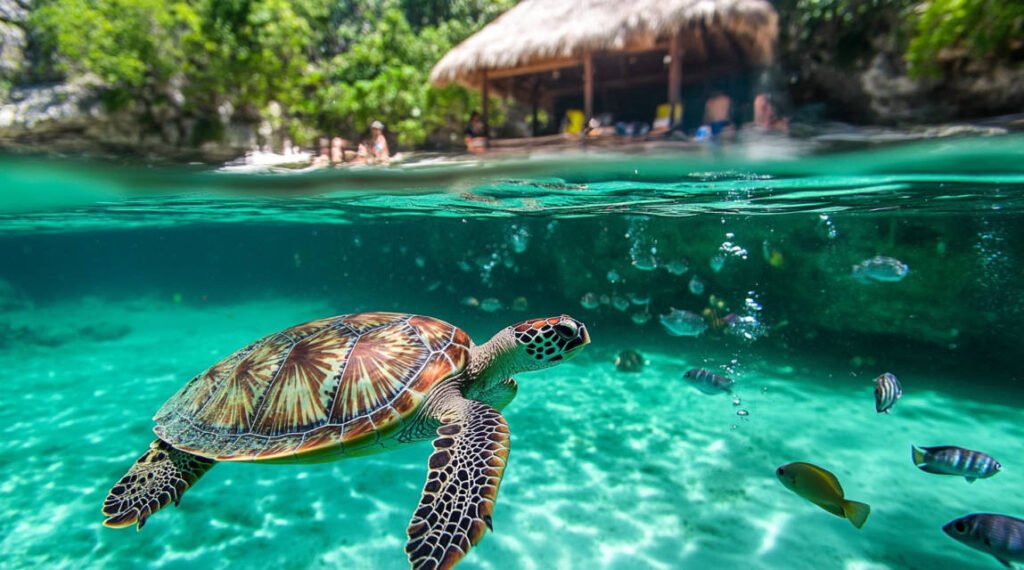
7. Cenote Carwash (Aktun Ha)
Easy entry and shallow waters.
Don’t let the name fool you; Cenote Carwash is a delightful dive spot. The entry is super easy—just a short walk from the parking area.
Abundant aquatic plants and freshwater fish.
The cenote is teeming with aquatic plants that give it an almost enchanted feel. Schools of freshwater fish dart in and out of the vegetation. It’s like diving into an underwater garden.
Visibility varies, adding to the adventure.
Visibility can change depending on the season, which adds a bit of excitement. On my dive, there was a slight greenish tint to the water, giving it a mysterious vibe.
Ideal for practicing underwater photography.
If you’re into photography, this is your spot. The unique lighting and abundant life make for some killer shots. I snapped some of my favorite underwater photos here.
8. Cenote Angelita
Known for its unique hydrogen sulfide cloud layer.
Angelita is famous for its eerie cloud layer caused by hydrogen sulfide at around 100 feet deep. As beginners, we’ll stay above that, but even from a distance, it’s a sight to behold.
Deeper sections for advanced divers, but upper areas suitable for beginners.
The upper sections are perfectly safe and suitable for newbies. Just be mindful of your depth, and you’ll be golden.
Eerie and enchanting diving experience.
The atmosphere here is unlike any other. The combination of the cloud layer and the surrounding trees that have fallen into the cenote gives it a haunting beauty.
Requires careful buoyancy control.
Buoyancy is key here. You’ll want to stay at your intended depth to fully enjoy the experience and stay safe. It’s a good place to practice those skills we talked about earlier.
9. Cenote Calavera (Temple of Doom)
Accessible via a short ladder descent.
Getting into Cenote Calavera is an adventure in itself. You climb down a ladder through a hole in the ground—how cool is that?
Three holes in the ceiling allow light beams to penetrate.
Once inside, you’ll see beams of light pouring in from the three holes above, creating a surreal environment. It’s both eerie and beautiful.
Shallow depths with fascinating rock formations.
The depths are manageable, and the rock formations are fascinating. I found myself weaving in and out of the structures, feeling like an underwater explorer.
Offers a thrilling yet safe diving environment.
Despite its nickname, “Temple of Doom,” it’s a safe and enjoyable dive. The thrill comes from the unique entry and the otherworldly atmosphere inside.
10. Cenote Jardin del Eden (Ponderosa)
Open cenote surrounded by lush vegetation.
Last but not least, Jardin del Eden is a slice of paradise. Surrounded by greenery, it’s like diving in a natural swimming pool.
Clear waters with plenty of natural light.
The visibility is excellent, and the ample sunlight makes it a welcoming spot for beginners. It’s a great place to relax and enjoy the beauty of nature.
Great for swimming, snorkeling, and diving.
This cenote is versatile. Whether you want to dive, snorkel, or just take a swim, it’s got you covered. I spent an entire day here and loved every minute.
Popular spot for training dives.
You’ll often see instructors with their students here, which speaks to its suitability for learning and practicing skills.
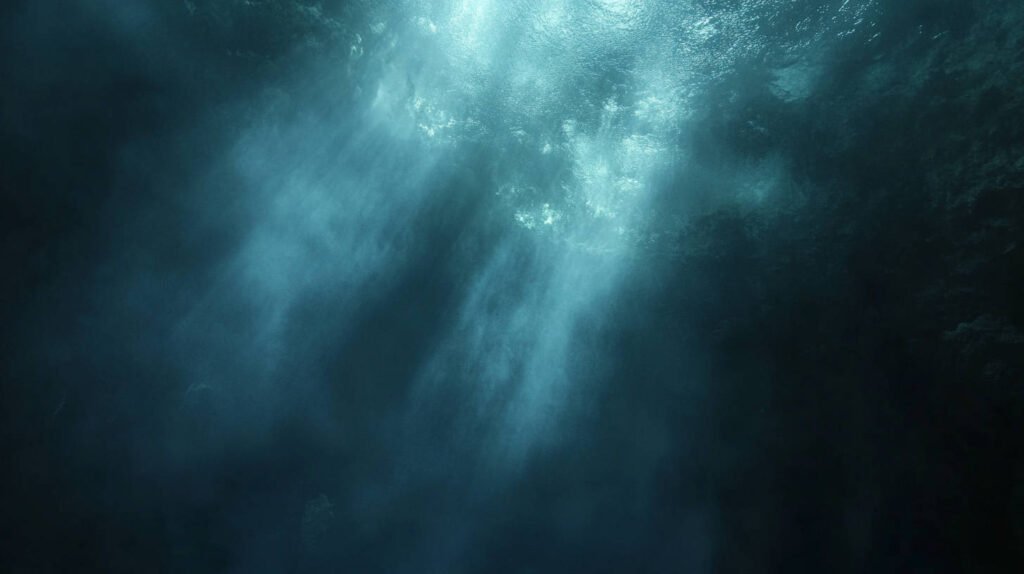
What to Expect When Diving in Mexican Caves
So, you’re gearing up for an unforgettable dive in Mexico’s caves? Let me paint you a picture of what awaits beneath the surface. Trust me, it’s like nothing you’ve ever experienced!
Water Conditions
First off, the water conditions are downright dreamy. Imagine slipping into water that’s a comfortable 77°F (25°C). It’s like diving into a warm bath, but with way better scenery! I remember the first time I dipped my toes into a Mexican cenote—I was amazed at how pleasant the temperature was. No need for those bulky, thick wetsuits that make you feel like a stuffed sausage.
But here’s a little tip: even though the water is warm, a 3mm wetsuit is still a good idea. It keeps you comfortable during longer dives and offers a bit of protection. Plus, it gives you that sleek diver look! Don’t forget to hydrate; warm water can make you forget you’re still losing fluids.
Visibility
Now, let’s talk about visibility. It’s off the charts! We’re talking exceptional clarity that often exceeds 100 feet. On my first dive, I could see so far ahead that it felt like I was flying through air rather than water. It’s surreal!
However, this amazing visibility means you need to be mindful of your movements. A careless fin kick can stir up sediment and reduce visibility—not just for you, but for everyone else. I learned that the hard way when I accidentally ruined a perfect photo op for my buddy. Oops!
Marine Life
While cave diving isn’t the same as exploring a bustling coral reef, there’s still plenty of fascinating marine life to encounter. Think fish, turtles, and unique cave-dwelling creatures that have adapted to the low-light conditions. I once came face-to-face with a blind cave fish. It was wild! These little guys have evolved without eyes because they don’t need them in the darkness.
And let’s not forget the turtles. Spotting one gracefully swimming by is like a little underwater gift. Just remember to keep your distance and not disturb them. They’re the real VIPs down there!
Cultural Experiences
One of the coolest things about diving in Mexico is the rich cultural backdrop. Many dive sites are near historic Mayan ruins, so you’re not just diving into water—you’re diving into history! After a morning dive, I loved exploring ancient sites like Tulum or Chichén Itzá in the afternoon.
It’s pretty amazing to think that these cenotes were considered sacred portals to the underworld by the Maya. Knowing this adds a whole new layer of awe to your dive. So, don’t forget to pack a bit of curiosity along with your gear!
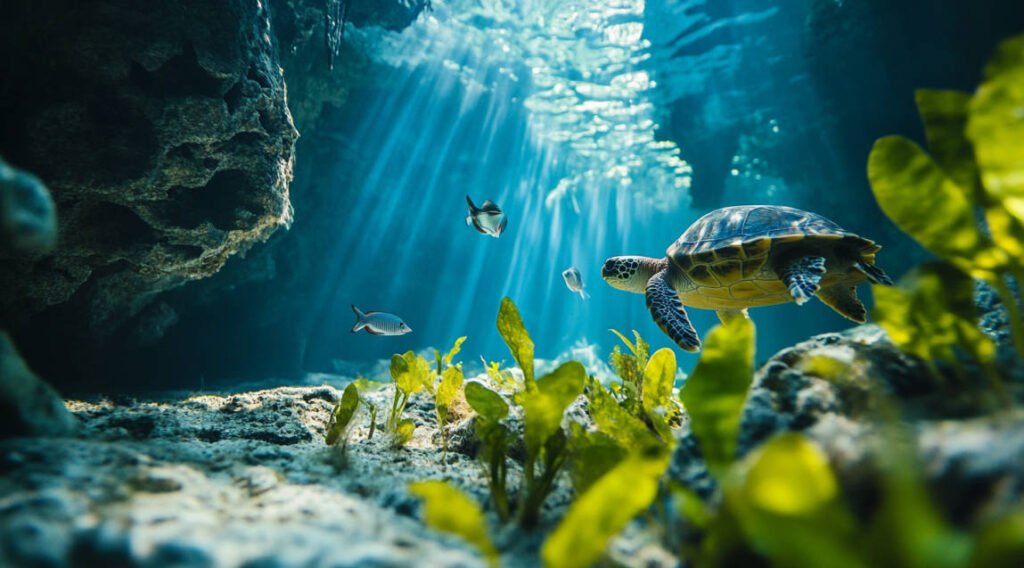
Safety Measures and Best Practices
Alright, let’s get down to brass tacks. While diving in Mexican caves is an incredible adventure, safety should always be your number one priority. Here’s some wisdom I’ve picked up—sometimes the hard way!
Follow Dive Briefings Carefully
First things first: always pay close attention during dive briefings. I know, sometimes they can feel like a drag when you’re itching to get underwater. But trust me, they’re crucial. I once zoned out during a briefing and missed important info about a low ceiling area. Ended up with a nice bump on my head and a bruised ego!
Your instructor will cover vital details like cave layout, potential hazards, and emergency procedures. Don’t hesitate to ask questions, even if you think they’re silly. Better to feel a bit awkward than to be unprepared underwater.
Use the Buddy System
Never, ever dive alone—especially in caves. The buddy system isn’t just a diving rule; it’s a lifeline. Having someone by your side adds an extra layer of safety and makes the experience more enjoyable. Plus, you can share those “Did you see that?!” moments in real-time.
I recall a dive where my flashlight decided to quit on me. Thankfully, my buddy was right there to lend me his spare. Crisis averted! It’s little things like that which remind you why the buddy system is so important.
Respect the Environment
These caves are delicate ecosystems that have been forming for thousands of years. Let’s do our part to keep them pristine. Avoid touching any formations or disturbing the wildlife. Even the oils from our skin can damage stalactites and stalagmites.
I carry a small mesh bag to pick up any trash I might find. It’s rare, but sometimes things like plastic wrappers make their way into the water. Every little bit helps, right? Let’s leave these natural wonders even better than we found them.
Emergency Procedures
Being prepared for the unexpected is key. Familiarize yourself with hand signals and emergency protocols before the dive. Know where the exit points are and keep an eye on your air levels.
During one dive, a fellow diver got a bit too excited and started breathing heavily, depleting his air faster than expected. Because we had reviewed emergency procedures, we were able to share air and make a safe ascent. It’s a reminder that things can happen, but being prepared makes all the difference.
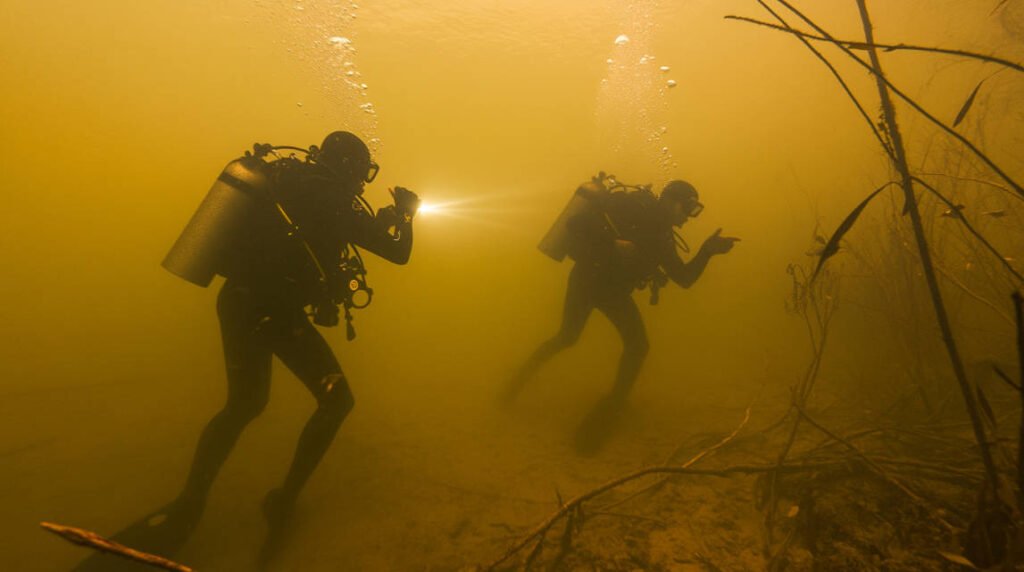
Planning Your Scuba Diving Trip to Mexico
So, you’re all set to embark on this underwater journey? Awesome! Let’s get your trip planned out so you can focus on having the time of your life.
Best Time to Visit
Timing is everything. The best months to plan your dive trip are from November to April. The weather is fantastic—warm but not scorching, and the humidity is manageable. I made the mistake of going in August once, and let me tell you, the heat and humidity were no joke!
During these optimal months, you’ll also avoid the hurricane season, which runs from June to October. Better safe than sorry, right?
Travel Tips
When it comes to flying in, your best options are Cancun or Cozumel airports. They’re well-connected and place you right near the action. I usually opt for Cancun because it’s closer to the cenotes around Tulum and Playa del Carmen.
Consider renting a car if you’re comfortable driving. It gives you the freedom to explore off-the-beaten-path cenotes and towns. Just watch out for those speed bumps, or “topes” as they’re called locally—they can sneak up on you!
Accommodation
From budget-friendly hostels to luxurious resorts, Mexico’s got you covered. If you’re looking to splurge, resorts in Riviera Maya offer all-inclusive packages that can be pretty sweet. On a tighter budget? No worries! There are plenty of charming guesthouses and hostels that are clean, comfortable, and won’t break the bank.
I once stayed in a small eco-lodge near Tulum. Waking up to the sounds of the jungle was an experience in itself. Plus, it was just a short drive from some of the best dive sites.
Dive Operators
Choosing the right dive operator can make or break your trip. Do your homework: read reviews, check their certifications, and maybe even reach out to past customers. A reputable dive school will prioritize safety, have well-maintained equipment, and employ knowledgeable instructors.
I had an experience where I went with a cheaper operator to save a few bucks. Big mistake! The gear was outdated, and the guide seemed more interested in his phone than in our safety. Lesson learned—sometimes it’s worth paying a bit extra for peace of mind.
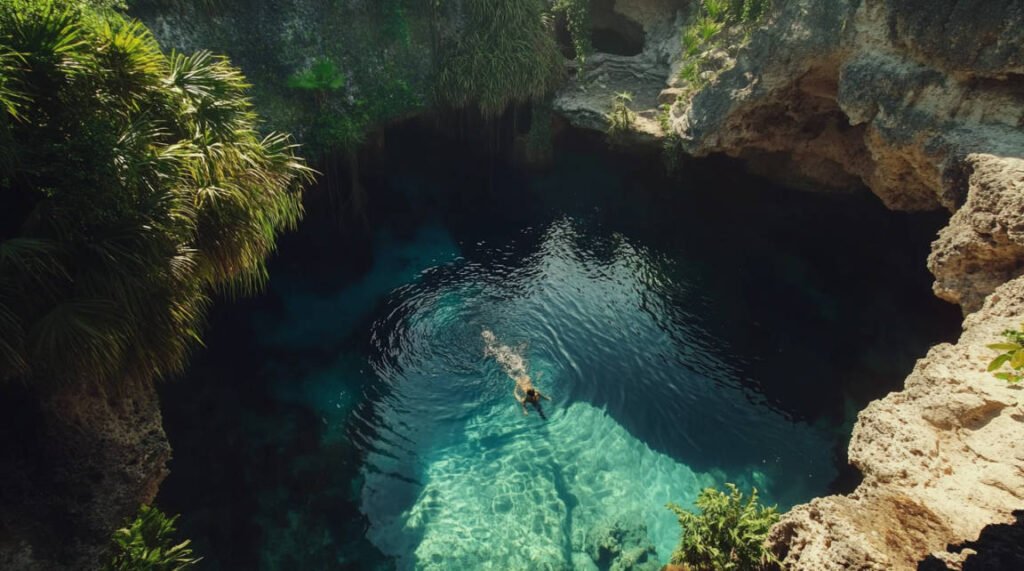
Conclusion
Embarking on a scuba diving journey through Mexico’s enchanting caves is an adventure you’ll cherish forever. From the serene beauty of the cenotes to the thrill of underwater exploration, there’s a whole world waiting beneath the surface! So pack your bags, grab your dive gear, and get ready to create unforgettable memories. The underwater wonders of Mexico are calling—will you answer?

